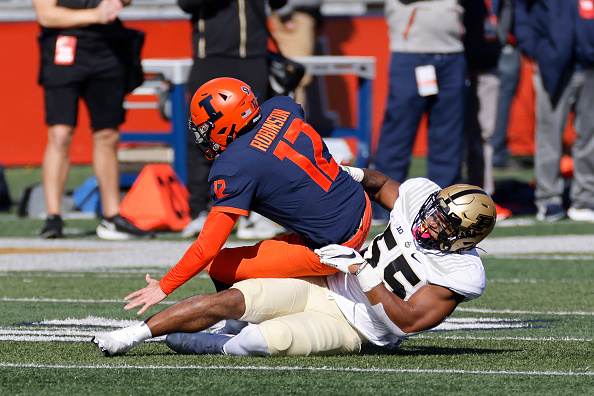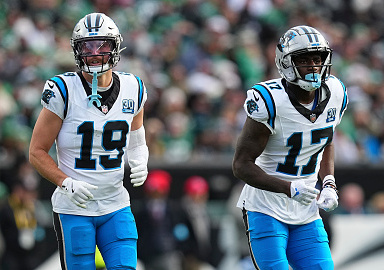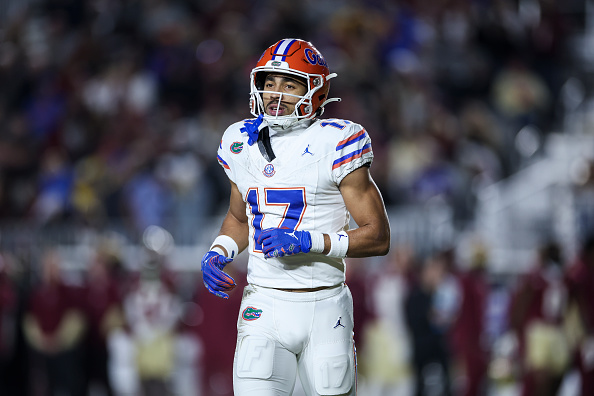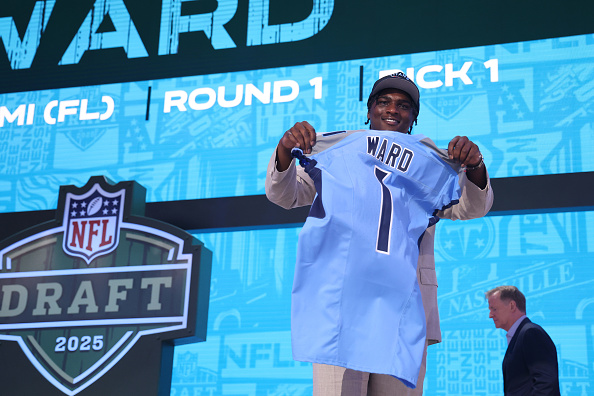Derrick Barnes kept teams guessing during a college career where he played multiple roles at Purdue. That same versatility will make Barnes a valuable Day 3 pick in the 2021 NFL draft. His ability to play both inside and outside linebacker and rush off the edge will surely earn him some interest. The team that takes a chance will get a flexible playmaker who knows how to wreck both phases of an offense.
Make sure to check out all of our other 2021 NFL Draft Scouting Reports.
Player Bio
Name: Derrick Barnes
Jersey: #55
Position: Linebacker/Defensive End
School: Purdue
Class: Senior
Height: 6’1″
Weight: 245 lbs
First-Step Quickness (4/5)
Barnes’ initial quickness is perhaps the strongest facet of his diverse skill set. He takes his first step in a hurry and is into his blocker in an instant. The speed of his opening move gives Barnes an obvious advantage in pass-rush matchups. That advantage is heightened by how Barnes plays stronger than his measurables.
Core Strength (3/5)
Barnes is never going to pass the eye test as a classic edge-rusher. He stands barely 6’1″ and has consistently hovered between the 240-45 lb mark. Fortunately, his play strength exceeds those dimensions.
Specifically, Barnes thrives by producing a formidable push when taking on offensive tackles. It comes in handy when using a bull rush to get to the quarterback. Barnes’ core strength means he also does a solid job of setting the edge in the running game, particularly against tight ends. Whether he’s able to transfer this play strength to the pros is a tricky intangible to gauge.
Closing Speed (2.5/5)
Barnes has no problem closing on the quarterback as a pass-rusher, and he shows no hesitation when attacking downhill against the run. There are some inconsistencies, though, when Barnes tries to track plays laterally. He doesn’t crawl when moving sideline to sideline, but Barnes’ steps definitely become heavier. It means he’s often too easily absorbed by blockers moving to the second level, especially on zone runs and screen passes.
Tackling (3.5/5)
The overall tackling technique is rarely as high as it ought to be in the NFL. Coaches simply don’t push form and fit principles as much as they should. In this context, teams picking in the later rounds will surely appreciate how cleanly Barnes tackles. He sets his feet firmly, keeps his shoulders square and head up, then wraps and drives the ball carrier to the ground.
There’s no wasted motion in how Barnes delivers hits, and his experience playing inside linebacker for the Boilermakers means he has a high appetite for contact. If there’s an issue, and it’s only a minor quibble, it’s that Barnes can sometimes lean too far into a tackle when trying to hit on the run, so he will lose balance at times in one-on-one situations in space.
Pass Rush (4/5)
A flair for getting to the quarterback will be Barnes’ best means of making an NFL team and getting on the field as a rookie. Like most skilled pass-rushers, Barnes relies on only a couple of moves that he’s honed to near perfection. The best of those moves is his bull rush. Look at these plays and note how quickly and firmly Barnes gets under the pads of his blockers and pushes them back.
Purdue LB Derrick Barnes dominated his Pro Day
Long Arms ✅
Stout Core ✅
Explosive Lower Half ✅Watch these clips of him playing EDGE. Powerful/flashing that closing burst!
Would love off-ball role in base & then subrush… Zone coverage scheme would love him! …Packers?! pic.twitter.com/Ke1pgiFyzi
— Ben Fennell (@BenFennell_NFL) March 24, 2021
Knocking a tackle off balance with a strong initial push is important because it sets up Barnes’ other moves, an inside slant. You can see it on the first and last plays shown in this video. What you also notice is the above-average closing speed Barnes uses to finish his rushes at the quarterback.
There’s even a nice swat-and-swim move on the second to last play, evidence Barnes knows how to use his hands to set up blockers and create separation. Putting all of these things together will make Barnes a useful pass-rusher at the next level. That is if his lack of bulk doesn’t count against him too often. Barnes can take inspiration from other undersized pass-rushers who’ve made the grade, like Shaquil Barrett, Elvis Dumervil, and Robert Mathis.
Coverage (2.5/5)
You could split Barnes’ performances in coverage into two distinct categories. He’s okay in zone but shaky in man coverage. Barnes has a decent understanding of zones. He knows when and where to drop, moves to the right depth, and does a good job reading routes in front of him.
It’s a different story when Barnes is asked to play man to man. He doesn’t match up well with tight ends because of his modest height, while mediocre agility means Barnes will lose running backs in space. That indifferent lateral quickness also means Barnes won’t effectively track receivers all the way through crossing patterns.
Recognition (2/5)
Barnes played in space often at Purdue, spending time at both linebacker sports. Yet the experience didn’t help him develop keen instincts diagnosing plays. He’s highly effective when allowed to keep things simple and play in a straight line. Things are different, though, whenever Barnes has to read counter or trap blocking. He also doesn’t always recognize molly blocks from guards or centers sliding out to the edge.
Playmaking (3/5)
Like most of Barnes’ attributes, you can split his grade here into two parts. He made plenty of splash plays as an edge-rusher in 2019. Barnes logged 63 tackles, including 11 for loss, and registered 7.5 sacks. Those numbers cratered when he was moved to inside linebacker for 2020. He snared an interception, but Barnes didn’t record a single sack.
Intangibles (3.5/5)
Any team running a hybrid defense will like what Barnes could bring to various positions. His time off the ball and experience on special teams should at least land him a role as a backup linebacker. Add in what he can do when he puts his hand down, and Barnes will have several chances to prove he belongs.
Purdue LB/DE hybrid Derrick Barnes has #Patriots written all over him. 3-year starter as a standup EDGE, hand-in-the-dirt DE, off-ball linebacker, and core special-teamer.
Very good play strength, frame for work in the trenches, open-field tackling, mirroring from 2nd level. pic.twitter.com/6RJcbqbccm
— Evan Lazar (@ezlazar) April 19, 2021
His main concern should be making sure his versatility doesn’t count against him and that teams don’t simply give up too soon trying to define where he should play.
Player Summary
Finding a niche role will help Barnes early in his career. His best fit is as a situational pass-rusher who can work both edges and even be moved into the A-gaps in certain blitz packages. A creative defensive coordinator should get plenty of use out of a flexible rusher who has the potential to develop into a consistent force off the edge.
Final Grade (28/45): Fourth- to Sixth-Round Pick
Player Comp: Bruce Irvin
Check us out on our socials:
Twitter: @PTSTNews and @TalkPrimeTime
Facebook Page: Prime Time Sports Talk
Join our Facebook Group: Prime Time Sports Talk
Instagram: @ptsportstalk
Follow James Dudko on Twitter @JamesDudko
Main Image Credit: Embed from Getty Images








2 Responses